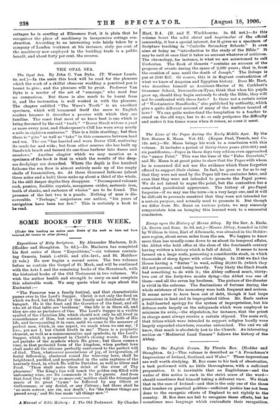THE OPAL SEA.
The Opal Sea. By John C. Van Dyke. ('r. Werner Laurie.
6s. net.)—In the main this book will be read for the pleasure which the work of a skilful observer wielding a practised pen is bound to give ; and the pleasure will be great. Professor Van Dyke is a master of the art of " seascape," who need fear no comparison. But there is also much to be learnt from it, and the instruction is well worked in with the pleasure. The chapter entitled "The Wave's Tooth" is an excellent specimen, which will !commend itself the more to English readers because it describes a process with which they are familiar. The coast that most of us know best is one which is being devoured by the said "tooth." "Dover Strait widens a yard or more every year, and Shakespeare's Cliff has worn away nearly a mile in eighteen centuries." This is a little startling ; but then there is "give" as well as " take " in this commerce between land and sea. The sea "has harried and worn Dover Cliff, scattering its sands far and wide; but from other sources she has built up Sandwich beach and turned its one-time harbour into dunes and meadows." Another chapter which we may mention as a specimen of the book is that in which the results of the deep- sea dredgings are described. Where the depth is five hundred fathoms the sea floor is almost entirely made up of the empty shells of foraminifera, &c. At three thousand fathoms (about three miles and a half) these make up about a third of the whole. In the still deeper depths they disappear. " Decomposed volcanic rock, pumice, Zeolitic crystals, manganese oxides, meteoric iron, teeth of sharks, and earbones of whales" are to be found. The presence of the last two is a puzzle. Nothing of man is dis- coverable. "Perhaps," conjectures our author, "his years of navigation have been too few." This is certainly a book to be read.


































 Previous page
Previous page